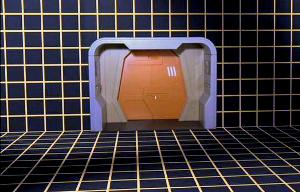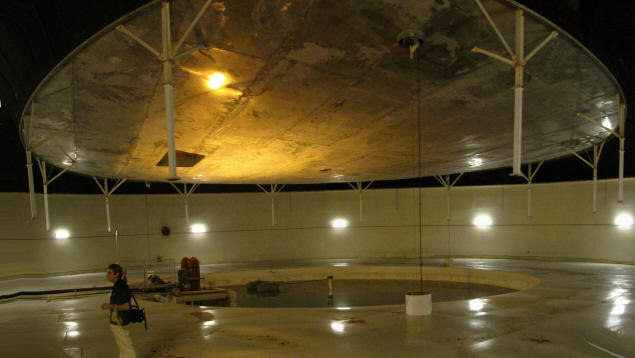| By: Paul S. Cilwa | Viewed: 4/28/2024 Posted: 6/5/2010 |
Page Views: 1124 | |
| Topics: #Arizona #Biosphere2 | |||
| Zach and I visit Biosphere 2, the world's largest greenhouse, with some friends. | |||
In October of 2007, I took Zach and most of the rest of the family to Biosphere 2, the world's largest greenhouse, near Oracle, Arizona. Today our friend Peter wanted to bring three young friends from Germany to see it and invited Zach and me to come along as experienced tour guides.
In my original post about Biosphere 2, I gave a pretty complete run-down of the place and its history; so I won't bother repeating that here. Instead, we'll just take a quick look at the changes since our last visit.
In addition to Peter, myself, and Zachary, we had with us two sons and a nephew of Peter's wife's friend, visiting from Germany. They are: Sylvan, 16 (nephew), and Eric (12) and Linus (13). (I apologize if I've misspelled their names.)
The fastest way to the Oracle area from my neighborhood (and Peter's) is to take US 60 a few miles west, then AZ 79 south through Florence. Just south of the town is a monument to a silent movie star, Tom Mix, one of the first movie cowboys, who died at this spot.
According to Wikipedia:
On the afternoon of October 12, 1940, Mix was driving his 1937 Cord 812 Phaeton near Florence, Arizona, (between Tucson and Phoenix) on Arizona State Route 79 when he came upon construction barriers at a bridge previously washed away by a flash flood. A work crew watched as he was unable to brake in time and his car slid into a gully. A large polished aluminum suitcase he had put on the seat behind him flew forward and struck Mix in the back of the head, shattering his skull and breaking his neck. The 60-year-old actor was killed almost instantly.
Of course, none of the kids with us had ever heard of Tom Mix. Despite his fame of a century ago, all that's left are a few silent moves (and a couple of poorly-received "talkies"), and this monument.
After about an hour's drive altogether, we arrived at the Biosphere 2 complex. (Biosphere 1 is Earth.) Peter paid our admissions, and we walked through the village where visiting scholars stay, to the steps leading down to the structure entrance.
Biosphere 2 itself, as one approaches, almost looks like Cinderella's castle or the Emerald City.
Our tour wasn't to start until 3 PM, so we took a little time to visit the exhibits that now occupy the spaces once used by the human residents of the Biosphere 2, known as "Biospherians", to perform experiments during the years they were locked inside.
Among the exhibits was a cast of a T-Rex fossil that had been found in the area. That, of course, excited the boys, who gathered around to inspect it.
This area also gave us a look at the first big change since
Zach's and my last visit in 2007. A large area had been devoted to
agriculture, growing the food the Biospherians were to eat while
locked inside, since the whole idea was that nothing whatsoever, not
even gases, were to come in or go out once the door was locked.
 But
those experiments have ended. So the agricultural section has been
completely cleared to make way for a new experiment that will study
the effect water has on shaping geologic processes. But for now, the
empty area is impressive in its own right, looking almost like a
Star Trek Holodeck in between programs. (And, in a sense, that's
exactly what it is!)
But
those experiments have ended. So the agricultural section has been
completely cleared to make way for a new experiment that will study
the effect water has on shaping geologic processes. But for now, the
empty area is impressive in its own right, looking almost like a
Star Trek Holodeck in between programs. (And, in a sense, that's
exactly what it is!)
We returned to what was once the communal dining area just before the tour was to start. All the original Biospherians were adults; what a shame—the exposed framework of the structure was ideal to entertain kids during the tour guide's pre-tour spiel.
After delivering a general overview, she opened the airlock and led us into first habitat zone of Biosphere 2. (There's an airlock because the most comfortable temperature and humidity for working humans is not necessarily that of the plants on the other side of the door.)
In fact, what was on the other side of the door (after a short walk) was Biosphere 2's ocean. It isn't enormous, but it's deep and has waves and a beach.
This is out of sequence, but here's a shot of the ocean taken from a different perspective, from over the beach.
Also, notice the cliff wall: It's actually made of cement very cleverly designed to resemble natural rock.
Of course, with my penchant for taking close-up photos of plants and flowers, I couldn't resist taking a few shots of the greenery that was so close…even though, as usual, I had no clue what kind of plants they were.
There are a number of different biomes in Biosphere 2, each with its own temperature and humidity requirements. Among other things, this means that rain must be created to order. The ceiling of Biosphere 2 is equipped with special nozzles that make it possible to do just that.
After touring several of these biomes, some of which were in the process of being reconfigured for new experiments, we all trooped down to the "basement" to see some of the inner workings that made this scientific tool possible.
Vast areas were taken up by air conditioners and water pumps. We stopped several times so our guide could explain what we were looking at.
Considering that English is a second language for our German visitors, the boys did amazingly well at following the lecture and, indeed, at keeping politely still during them.
After having been shown various pumps and compressors, we took a brief shortcut through the rain forest…
…to a low, 8-foot-long tunnel through which we had to stoop…
…to get to what is, arguably, the single most impressive yet understandable piece of technology in the entire complex: The Biosphere 2's "lung".

So large it can't meaningfully be squashed into even a panoramic photo, the lung solves this problem: Biosphere 2 encloses a huge space, which by intention receives the light and heat of the sun through hundreds of thousands of panes of glass every day. As it warms throughout the morning and afternoon, the air inside expands, as warm air does, creating higher air pressure inside than out—which, if nothing were done, would blow out those very panes. So a "lung" was built of a massive, one-piece, rubber gasket and a huge iron weight combination. As the air expands during the day, it rushes into the lung where the iron weight rises and the gasket expands. When it cools in the evening, the air returns to the greenhouse thanks to gravity's pulling down the iron weight.
After we had adequately marveled over the lung, we stepped outside the building (almost flying out on the rush of air through the opened air lock) and got a look at the short, constricted tunnel from the outside.
As we walked outside back to where the tour began, I was struck with the beauty of the grounds and the structure itself. From an engineering standpoint, there is no doubt that Biosphere 2 is a marvel and technically beautiful. That it is also aesthetically beautiful doesn't necessarily follow, but is certainly the case.
And the landscaping around it contributes, with the color and scent of flowers decorating every turn.
The tour over, we applauded our guide and made our way back through the village to the parking lot. The village itself, though, catching the late afternoon light, also contributed to the general sense of beauty about the place.
I especially appreciated the stark contrast of colors between the deep blue sky, the adobe walls, and the blossoms of the yucca plants.
So, after the required restroom visits, we piled in the car and made it home via a different route that took us through some mountain passes for the entertainment of the boys, passing through the town of Kearny and a series of active copper mines, then the near-ghost town of Superior whose mines have mostly closed. We got back home shortly after 7 PM, and said goodbye to our new German friends after another enjoyable day of showing off Arizona.





